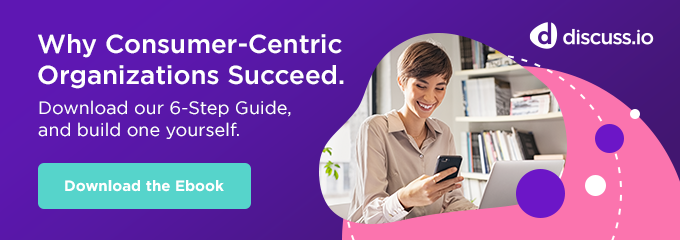KEY TAKEAWAYS:
- While quantitative analytics provide data points from the customer journey, qualitative analytics will help you understand the deeper motives, behaviors, and other variables that affect the online process–the “why” behind the “what.”
- Conversion rates and KPIs vary by vertical, with significant differences between B2B and B2C companies.
- Interviewing customers and stakeholders is one of the most useful qualitative research methods to uncover insights that help organizations with conversion rate optimization.
When asked what the golden rule of optimization is, Dr. Flint McGlaughlin replied simply: “Specificity converts.”
McGlaughlin is the founder of MECLABS, the world’s largest independent research institution focused on offer response optimization, so he knows a thing or two about conversion rate optimization (CRO). Expanding on his thought, he continued:
“The more specific/relevant you can be to the individual wants and needs of your ideal customer, the more likely the probability of conversion… A framework based on understanding your customer will yield more consistent, more rewarding results that only improve over time. The first key to rethinking your approach to optimization is to construct a robust customer theory articulating your best understanding of your customer. From this, you can transform your ideas into hypotheses that will begin producing invaluable insights to lay the groundwork for how you communicate with your customer.”
One of McGlaughlin’s key principles for optimization is that it is not merely about optimizing elements on a page; it is about optimizing a human thought process. You can move the pieces of a landing page or homepage around, but are you answering the key questions in a customer’s mind so that the customer feels comfortable with the site and begins to build trust in moving forward with a relationship with your brand?
You can find out the answers to key questions regarding motivation, how customers feel about your brand’s value proposition, and other emotions they may have through the use of both quantitative and qualitative research.
Customer Obsession and CRO Start with Research
CRO tends to be primarily based on quantitative information and key performance indicators that show routes followed by users and actions taken in conversion funnels. Quantitative data is useful to identify material issues, such as bounce rates or pages that should be optimized. While quantitative analytics provide data points from the customer journey, qualitative analytics will help you understand the deeper motives, behaviors and other variables that affect the online process.
Qualitative data are beneficial when you are looking for the motivation behind the action (e.g., the reason for the bounce rates on a certain page). Qualitative research, then, helps you develop a customer-centric culture that supports your continuing CRO efforts.
Qualitative Analytics Differ by Vertical
Qualitative CRO aims at getting information about users such as their online persona, their objectives in getting through the online process, the path they are following, and/or the frictions and obstacles they are encountering.
While there are some common measurements to gauge customer wants and needs, conversion rates and KPIs will largely vary by vertical – with significant differences between B2B and B2C companies.
| Vertical Examples | CRO Goal | Common Qualitative Analytics |
| Ecommerce/Retail | Convert prospects into paying customers | Landing page information
Cross platform functionality Website information/image optimization Live chat Checkout process |
| Fintech/Healthcare | Help users use all features and applications, modify or add their account | Security/ID management
Integration with other fintech/health apps Transaction process Personalization Accessible analytics |
| SaaS/IT | Accelerate customer acquisition or upsell | Value proposition/Reason for subscription
Video/Demo/Free trial Efficiency of sales model (customer, transactional enterprise) Product features communication |
Online Market Research Uncovers High Impact Analytics
In any online transaction, multiple inputs such as customer journey, buyer behavior, live chat support, email, on-site feedback forms, and even phone calls can be monitored to get information about a specific user.
| Qualitative Analytics Techniques | Goal |
| Buyer Persona Definition | Break down user complexity into improved decision making – particularly important for regional differences |
| User Journey Scenario | Improve customers’ understanding to provide value where they require it |
| Focus groups | Generate hypotheses for split testing or other website evaluation. The scientific method of marketing starts with formulating questions to ask. |
| User Surveying | Come up with experiments. The goal is to find out as much possible about why customers purchased as well as why they almost didn’t purchase. |
| Web survey | Understand behavior – Mostly Y/N answers, but if user answers no, the popup should give the user the opportunity to provide more information. |
| Demographic and psychographic analysis | Capture personality, values, opinions, lifestyles to understand who buyer is |
| Web psychology | Study psychology of online audience |
| A/B Split testing
Multivariate testing |
Modify one thing on a page and redirect 50% of traffic to see impact of change
Change multiple variables to test various combinations |
| User testing
Usability testing |
Watch someone use website
Run testing by a usability expert |
| Livechat | Show what is either missing or not being made clear enough on website |
| Eye tracking and heatmap analysis | Examine what users are looking at and clicking on |
| Analytics | Use tools like Google Analytics |
Primary market research focuses on user experience, perceptions, beliefs, and attitudes. Some upfront work may be required to gather information on customers’ past purchasing habits from internal CRM and web analytics before selecting the appropriate research method:
- Online in-depth interviews (IDIs) – Enable the interviewer to follow an individual’s train of thought to the root of what he thinks and does during his online iterations.
- Interviewing customers and stakeholders enables brands to get insights from what they need to make a buying decision or how they see the value.
- Formal internal discussions with Customer Service and Sales can bring up problems they are directly dealing with—both in relation to the website and the product. Employees are also familiar with the decision-making process of the target audience and can contribute to better optimization.
- Online focus groups and video platforms – Help find out what stimuli such as new webpages communicate to consumers and provide insights on different digital experiences. Focus groups also offer a great opportunity to check how a value proposition resonates with the target audience.
Key Insights From Market Research Drive Better Customer Understanding
Optimization is driven by attention and external motivation. As a result, questions will focus on issues such as goals, problems, frustrations, and product value. Insights can span across different categories:
- Customers: Learning who the customers really are, their language, wants and needs, doubts and hesitations
- Usability and performance: Errors, task time, test level satisfaction, conversion
- Interaction design: Frictions during customer journey, FUDs (fears, uncertainties, doubts) experienced while on a specific page
- Design improvement: Landing page, content, infographics
At Amazon, traditional methods of primary research such as focus groups are sometimes used. Amazon Preview gathered opinions from a selected group of “best customers” early in the development process. More importantly, for two days every year, Jeff Bezos asks thousands of Amazon managers, including himself, to spend time at call centers interviewing and listening to customers to gain a better understanding of their wants and needs.
Insights Must Lead to Action
Of course, gathering insights about your customers is only valuable if you take action on what you have gleaned from your research. The next step in conversion rate optimization is to test your insights by implementing changes to your website in line with your hypotheses. Then, measure the results.
As you might expect, CRO is a continual process of maintaining a laser-focus on customer wants and needs and acting on what you discern. This customer-obsessed strategy has catapulted Amazon to its 74% conversion rate. What will it do for your brand?
Let Discuss.io Feed Your Customer-Obsessed Strategy
Discuss.io is a smart video platform purpose-built for qualitative research. From in-depth individual interviews to online focus groups, Discuss.io facilitates qualitative research at scale. It enables researchers to record, archive, and share interviews and make them searchable by keyword, topic, project, and more.
Discuss.io is uniquely designed to help brands capture the voice of the consumer and infuse that voice throughout the breadth and depth of the entire organization to enable intelligent decision-making at every level.
Want to learn more about why consumer-centric organizations succeed? Download our 6 -Step Guide, and build one yourself to find out.





